A famous painter once said, “If you love nature, you’ll find beauty everywhere.” Well, Jibhi can help you “feel” his words.
Let Jibhi take care of your well-deserved break if you enjoy lush greens and want to spend it amidst greenery. Sitting at an elevation of 1600m, 5250* feet, Jibhi village is one of the unexplored places in Himachal Pradesh. The place is surrounded by splendid and vibrant greenery with a lot of traditional Himachali houses and homestays.
It is snuggled amidst pine trees and deodar trees and is a pleasing place for a peaceful stay in the foothills of the Himalayas. Jibhi maintains a great climate throughout the year, and each season offers some thrilling and daring activities to keep you busy.
Known for its otherworldly landscapes and rich traditions/culture, Jibhi travel experiences offer a truly treasured and unique experience. You will be fascinated by the beauty of innumerable villages and hotspots. Additionally, this place has some terrains that are ideal for trekking.
So, in this blog, we’re going to talk about the best places to visit in Jibhi that you shouldn’t miss at all while you’re here. And yes they’re worth the hype. Go ahead!!
Best Places to Visit in Jibhi
1. Jalori Pass/Serolsar lake
2. Rahgupur Fort
3. Shojha
4. Chehni Kothi
5. Shringarishi Temple
6. Jibhi Waterfall
7. Gushaini Village
8. Bahu Village
1. Serolsar Lake
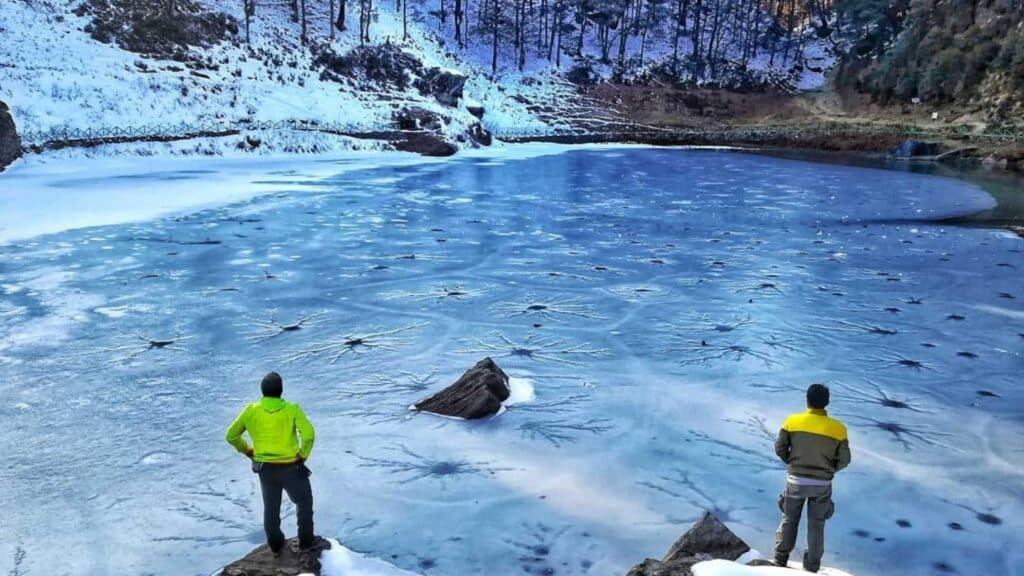
Photo By – Saurabh Sabikhi
There’s a saying that the most picturesque places are hidden away in corners that aren’t so easy to reach. Serolsar Lake is one of those places. In the luxuriant forests of outer Seraj, the Serolsar lake trek is a great way to begin your Jibhi trip. This lake is concealed among a forest of pine trees six kilometres from Jalori pass, which is known for its incredible views. Don’t miss this place if you love hiking. In the midst of striking trees and rocky slopes, this is not a trek, but we’d rather say it is a 3 km long walk.
A golden citadel lies at the bottom of Serolsar Lake which is regarded as the residence of the Budhi Naagin, mother of all Nag (Snake) Deities of Himachal like Shesh Nag, Kamru Nag, Ghunda Nag, and Mahu Nag.
Serolsar Lake has an exciting story about a Brahmin who drowned himself while sauntering around the lake one day while visiting a nearby village. His life was saved by the Goddess. The Goddess even allowed the Brahmin to stay in her golden citadel for three years if he promised not to talk about the same. When the Brahmin returned to his family after 3 years, they were inquisitive about where he had been for so long, since they presumed he was dead.
His whereabouts were constantly asked, but he dodged them. However, when he told everyone what had happened, he died immediately. The news shocked his family and friends. Each time they tried to visit the lake, they encountered mysterious accidents, and no one from his family understood the mystery. As of yet, no geological study has been able to precisely calculate the lake’s depth. Perhaps the Budhi Nagin wants to remain peaceful in her Golden Citadel.
Do not take a dip in the lake or stand on it when it’s frozen. Instead, offer your prayers to the Budhi Nagin. Do so in the nearby temple, not in the lake. Take pictures, make videos, and listen to some songs that you can relate to. That’s what we do these days. Isn’t it?
2. Raghupur Fort
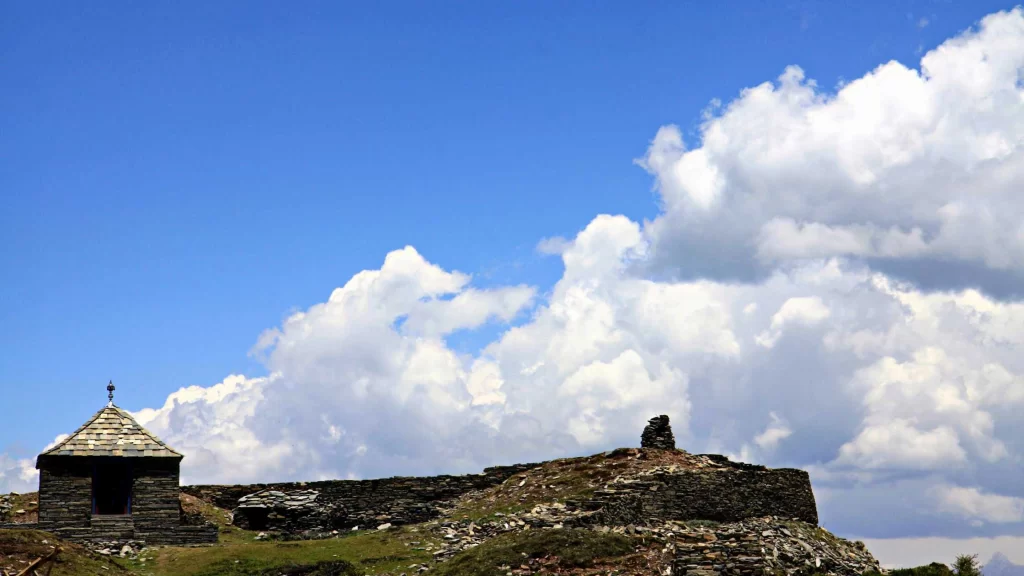
Photo By – Madhu Nair
Located in the lesser Himalayan region, this picturesque trail offers an excellent opportunity for young wannabe trekkers and bird watchers to gain experience in trekking in a variety of environments. This can be from dense deodar forests to open grassy paddocks. In the days of British rule, this trail was one of the access routes from inner to outer Seraj. They used it to pass their groups while travelling between Kullu and Rampur or Shimla.
In order to protect themselves against the invaders, the Mandi rulers built Raghupur Fort. As of today, only the outer portions of the walls are left. However, the way to reach this fort makes it more fun. This is a three-kilometre walk from Jalori Pass, with the last kilometre being sheerer than the others. Rhododendrons and oak trees line the path, with the Himalayas as the milieu. The fort has a small pond on its premises.
There are no words to describe how amazing and awe-inspiring this location is for shooting photos. Your time might just slip away as you lose yourself in nature.
Read More: Cafes in Jibhi: 10 Awesome Places to Sink Your Fork in!

Photo By – Surya
Shojha is another yet one of the most beautiful places near Jibhi that shouldn’t be missed at all! This hamlet is surrounded by lush green forest which looks incredibly beautiful. Well, a few of the Bollywood films have been shot here like Yeh Jawaani Hai Deewani and Tere Naal Love Ho Gaya. Jalori Pass is just 5 km from here. You can trek to the same place while enjoying a healing walk amidst the dense forests. Trust us, the path is meant to be clicked. It’s so pretty!
The main highlight of this quaint village is its calmness. It’s so quiet and peaceful. You’ll love reading books here even if you’re not a reader. Perhaps it’s just for the pictures, but you’ll definitely feel like holding a book here! It’s an ideal place to escape if you want to say goodbye to those boring weekends.
There is no best time to visit Shojha, you can visit here anytime however if you’d ask us, it’s between March to June, a time when you see those blooming flowers plus the temperature is also moderate, so ya us it’s a good time.
Read More: 10 Awe-inspiring Campsites in Jibhi, Kullu
4. Chehni Kothi

Photo By – Sahil
Shringi Rishi Temple in Bagi Village is where you will start your trek to Chehni Kothi. It is about 3 km from Jibhi to Banjar, where the road divides Bagi. As there are no local buses that go to this place, you’ll need to arrange for a cab. You can trek to Chehni Kothi for an hour from Shringi Rishi Temple. There is clear signage on the trail, so it can be done without a guide.
An unspoiled and isolated village in Jibhi valley, Chehni Kothi is situated in the hills. This village is well-known for its two temple towers located at a height of 2145 meters above sea level. Folklore says the temples are over 1500 years old. This has not been documented in writing. The temples were built by King Dhadhu around the 17th century and are locally referred to as Dhadhiya Kothi.
No matter how old the tower is, it is enormous! The tower is about 30 meters high and made without any concrete or steel. The tower was even taller before the earthquake of 1905, but it lost a few meters. As of now, the shorter tower is used as a temple.
The towers cannot be climbed by outsiders as per local customs. Do not act witty, even if there is no one around. In case of a refusal, ask politely without being rude.
Read More: Best Hostels in Jibhi For Backpackers and Budget Travellers
5. Shringa Rishi Temple
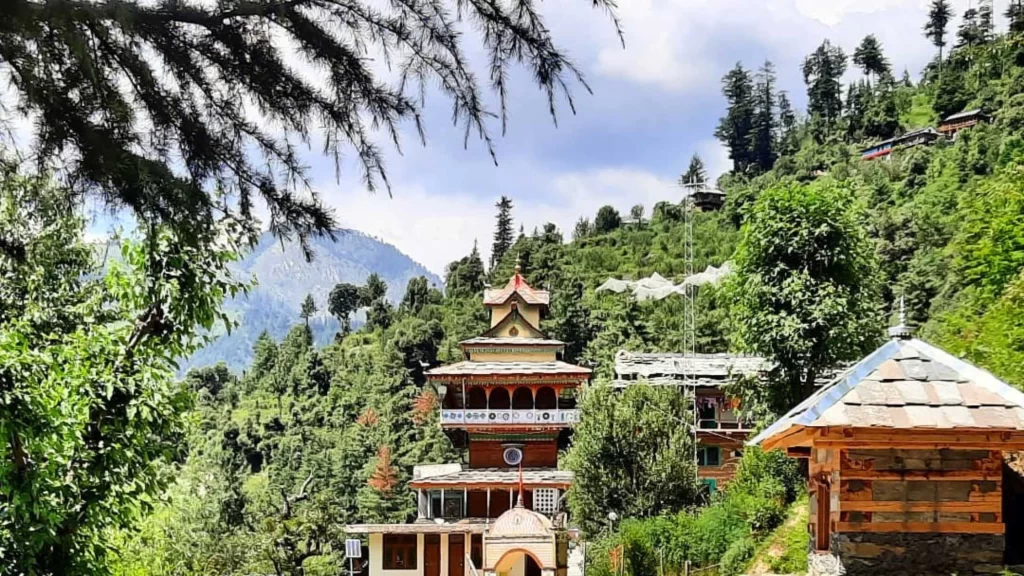
Photo By – Yamini
Banjar Valley is considered to be under the rule of Rishi Shringa, the deity of the valley. It is believed that this valley was used by the Rishis as a location for meditation, or tapa Bhoomi. Several impressive stories mention a sacred stone found in Skeeran’s forest known as a Pindi (a sacred stone). People were urged to install the Pindi in a temple. The Skeeran forest eventually became the site of a temple constructed by the village folk. However, travelling to worship was really difficult for them. Hence, another temple dedicated to Rishi Shringa was built in Bagi Village. The newly constructed Shringa Rishi Temple is 12 km away from the old one.
There is a strong association between the region and the birth of Lord Rama. Rishi Shringi, whose Ashram was at Chehni during the age of Satyug (the Golden Age), was privileged to act as Purohit (sage) at Raja Dashratha’s Putreshtiyajna during the Ramayan “Kal”. It is said that Rishi’s actions and prayers led to the birth of God Rama. Due to its peace and serenity, Banjar Valley is believed to have been visited by many Rishi’s (sages) and Nag Devta during Satyug.
In this region, the rishi is known as Skirni Deo. It is believed that Skirni Deo was the king of Kaliyuga. There is a wood-made forehead of Shringi Rishi at Skiran (12000 feet), where the Pindi of Shringi and Bhagvati Shanta can be seen. It was rebuilt after 60 years in 2008. Shringa Rishi is an influential historical deity of the Kullu, also associated with eighteen primary deities of the Kullu.
A visit to this temple will give you a sense of Incredible India because here sages worshipped, kings were holy, and supernatural powers could be found. There is much to learn about this temple just by visiting it once. Seeing it is the only way to truly escalate it. Every year, usually in May, priests, and locals visit the Shringi Rishi Temple to perform pujas. Other than that, the place is heavily covered in snow throughout the year.
Read More: Get Cozy in the Mountains: The Best Homestays in Jibhi!
6. Jibhi Waterfall
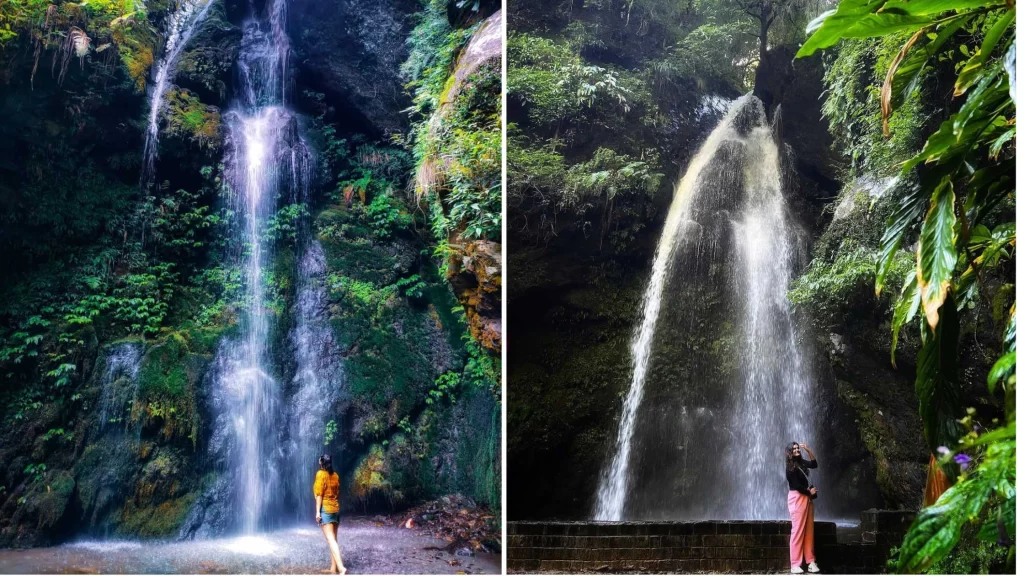
Photos By – Rashmi & Prashali
The waterfall is one of the most accessible attractions in Jibhi. The site is located deep inside a forest. The path leading to the waterfall is lined with abundant wooden bridges, which add to the beauty of the place. It is hard to describe how wonderful it is to hear the sound of a waterfall hitting hard rocks. Early in the morning, you may also see a rainbow in the waterfall.
A visit to Jibhi waterfall is one of the best things to do in Jibhi, Himachal. A pacifying view makes this place a perfect place to spend time with your partner. The freezing waters of the mountains are also perfect for a dip. Jibhi Waterfall is famous as a picnic spot for the residents. Take a dip, take pictures, splash around and have fun!
7. Gushaini Village
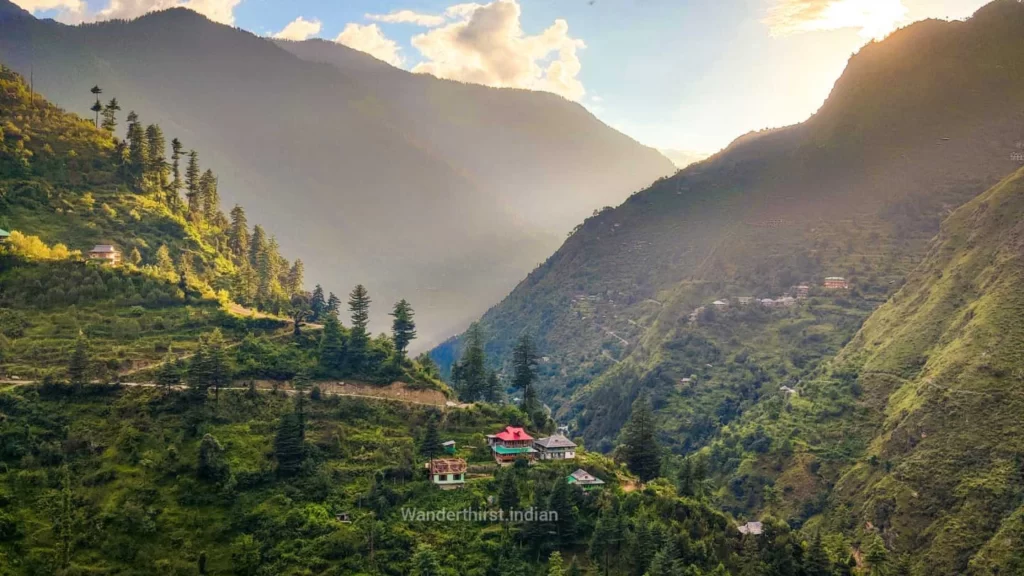
Photo By – Jigar
It could be anything starting from Trout Fishing to living in a tent in Gushaini village. By surrounding the Tirthan River with natural copses of hills, the lush green Himalayas highlight its charismatic aura. Tirthan Valley can be described as calm, cool, and collected like the river that flows through it. With such calm, so tranquillity – you’ll soon slip into a trance. There are also epic Himalayan Trout in this river, which is why this valley is sometimes called Trout Country.
Homestays are made of Deodar wood to prevent freezing temperatures. Beautiful birds and a gentle breeze make the place even more magical. It is a village with a garden full of apricots and pomegranates, so you can enjoy eating fresh fruits. As sunlight glimmers through the pine trees, the light flickers across the branches making the village path look more tempting. When it rains, the weather looks mesmerizing. Gushaini Village in Jibhi Valley is jam-packed with love because of its natural light, fairy tales, village foods, and superb weather.
Read More: Malana Village – History, Culture and Things to Do
8. Bahu Village
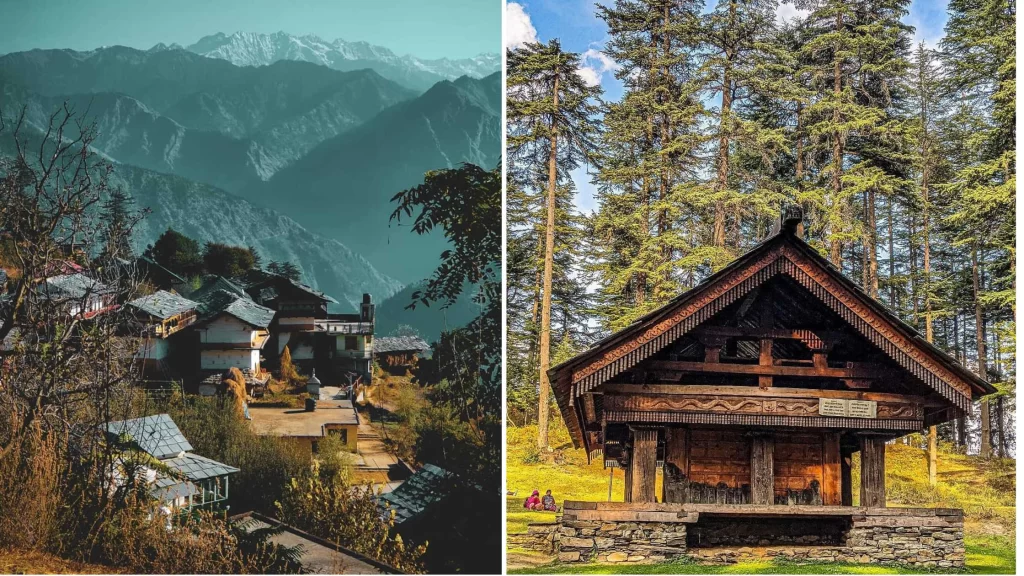
Photos By – Akash & Haritha
Bahu is a small hamlet situated 9 km from Jibhi. As a bonus, it’s incredibly quiet. Bahu is surrounded by pine and cedar forests and is certainly not the place for you if you want to do lots of shopping, try different kinds of food and eat in some cafes. Bahu would suit you well if you like off-the-wall destinations, silent places, shooting, staying away from the throng and discovering unknown places. It’s really hard to describe the beauty of this village. It’s flawless! You have to crash here to believe us.
Best time to visit Bahu you ask? Well, it depends solely on your goals. The best time to visit Bahu is between the months of March and June. But then a lot depends on why you are visiting.
If you’re a snow sweetheart and possibly wanna see a live snowfall, you will have better luck in January and February. In order to see the apple trees in bloom in the valley, you should visit Bahu during the spring season, which is from March to June. Anglers interested in Trout fishing can visit this place between March and October. When it comes to trekking and camping, you should avoid the monsoon season and perhaps winter as well. Nevertheless, if you want to experience plush green views and charming beauty at its best, July, August, and September are the best months.
Jibhi is garlanded with picturesque sceneries, colourful flower fields, and idyllic villages bursting with history, culture, and art. Jibhi will remain in your heart forever as a reminder of Himachal Pradesh’s big-heartedness.
Have we convinced you that Jibhi and its unusual beauty are just waiting to be explored? Be sure to keep the above list handy, plan your trip around a time when the weather will be ideal, and then book. You will surely find something memorable in Jibhi that’ll make your holiday a wonderful experience.
And yes, for travellers this list does not stop you to explore more. If you have already been to some hidden places in Jibhi, do tell us and share your experiences. We’ll be more than grateful.
Feature Image By – Whispering Pines Cottages

